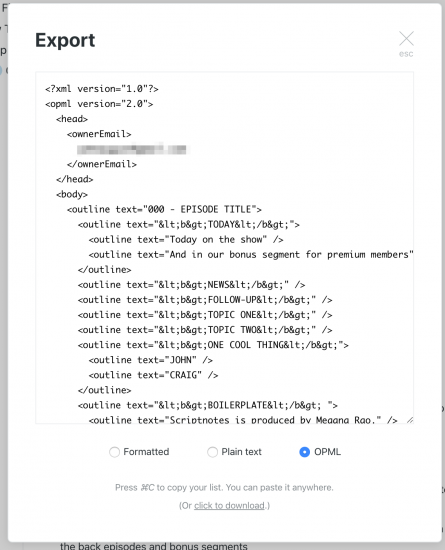 Many listeners have asked how Craig and I record our weekly podcast. I [wrote about it in 2013](https://johnaugust.com/2013/how-we-record-scriptnotes), but a few things have changed. So here’s an updated look at our standard operating procedures and gear.
Many listeners have asked how Craig and I record our weekly podcast. I [wrote about it in 2013](https://johnaugust.com/2013/how-we-record-scriptnotes), but a few things have changed. So here’s an updated look at our standard operating procedures and gear.
### When and what
Scriptnotes producer Megana Rao and Craig’s assistant Bo Shim figure out when we’re going to record. It’s usually a Thursday or Friday, late in the afternoon. Megana and I have usually talked over potential topics, but Craig and I will also text during the week to discuss. If it’s a [Three Page Challenge][3pc], Megana will send each of us PDFs of the entries she’s picked.
We’re all working off a shared outline in [WorkFlowy](http://workflowy.com), which includes the episode number, today’s topics, listener questions, various housekeeping bits, and our [One Cool Things][onecoolthing]. I recently made a [template](https://beta.workflowy.com/s/000-episode-title/9fdwp8NdYjZge65C). If there’s anything we need to read aloud — for example, a quote from an article — I usually copy-paste it into this outline.
Since Craig works in Pasadena and I work in Hollywood, it’s not practical for us to be in the room together, so we record the podcast on Skype. This is the part many people can’t fathom — *we’re almost never in the same room together.* I lived in Paris during 2016 and 2017, yet we kept doing the show pretty much as normal. Whether you’re miles or time zones apart, you can do it.
It takes practice to keep up a conversation when you don’t have the usual physical cues. The first few episodes were rough. But I think the podcast is actually much better with Craig and I being apart; like the audience, we’re only hearing each other’s voice, so everything we’re communicating needs to happen in speech.
I don’t care about hearing myself through the headphones, but if you do, you may want to consider a setup that lets you plug headphones into the mic or mixer. If you let the audio round-trip through the computer, the lag will drive you crazy.
### Editing
While Craig and I are talking on Skype, each of us has QuickTime running on our own computers to record only our side of the conversation. (File > New Audio Recording…) When we finish recording, we each save our audio into the same shared Dropbox folder. From there, editor Matthew Chilelli yanks out the audio and marries the two tracks in Logic.
Many podcasts simply record the Skype call, saving the step of marrying the two tracks. But it’s very handy to be able to manage the two sides of the conversation separately. We can edit out background noise and generally keep it much tighter.
As a backup, we have [Call Recorder](https://www.ecamm.com/mac/callrecorder/) for Skype running. It’s saved our bacon a few times.
Matthew ends up editing two versions of the episode: the normal one and the premium version, which includes an additional segment at the end. When he’s finished — generally Monday at around noon — he’ll put them back in Dropbox. Megana listens to them and writes up the text for the post, along with links and the outro. I sign off, then all that gets added into the files.
Megana then uploads the premium file to our [subscription service](http://scriptnotes.net), where it comes out immediately. She schedules the normal version to come out Tuesday morning.
###Nuts and bolts
For hardware, we started with Dan Benjamin’s really useful guide to [podcasting gear](https://danbenjamin.com/podcastmethod/), but ultimately made different choices over the years. I’ll include Amazon referral links for items available there, but certainly consider local retailers — or items you may already have.
For my mic, I’m using the [Shure BETA 87A Supercardioid Condenser Vocal Microphone](https://amzn.to/3kiPmCQ) mounted on a [Heil PL-2T boom][boom] with some generic pop screen. This mic requires a pre-amp and USB interface, so I’m using the [Focusrite Scarlett 2i2](https://amzn.to/3gvLYSO), which feels like overkill but has been problem-free for many years.
When I’m traveling, I’ve been packing the [Samson Q2U Handheld Dynamic USB Microphone](https://amzn.to/2Px6sig) instead. It’s really good for the price and simply plugs into USB. When we have remote guests I’ll often drop this mic off at their house if they’re in town, or just Amazon it to them if they’re somewhere else.
For listening, there’s nothing better than the Sony [MDR-7506 headphones][headphones], which not only sound great but seal well, keeping Craig’s audio from being recorded on my track. I like them so much that I’ll bring them with me on a trip.
Before the pandemic, we were recording more shows in-person at my office using a [RØDECaster Pro](https://www.rode.com/rodecasterpro), which is genuinely terrific. It combines a pre-amp, USB interface and recorder into a single interface. The new Zoom [PodTrack P4](https://zoomcorp.com/en/us/podtrak-recorders/podcast-recorders/podtrak-p4/) looks to meet a similar need and is probably also great. I’ve had a good experience with various Zoom recorders over the years.
For live shows, I’ve generally been recording on the [Zoom H6 digital recorder](https://amzn.to/33x0zd6). Even if we’re using audio from a sound board, I’ll still aim the Zoom at the audience to gather crowd noise.
[3pc]: http://johnaugust.com/threepage “three page challenge”
[onecoolthing]: http://johnaugust.com/onecoolthings “one cool thing”
[utility]: http://atp.fm/episodes/25-thrustmaster-joystick “slip sync”
[at2020]: http://www.amazon.com/gp/product/B001AS6OYC/ref=as_li_ss_tl?ie=UTF8&camp=1789&creative=390957&creativeASIN=B001AS6OYC&linkCode=as2&tag=johnaugustcom-20 “at2020”
[boom]: http://www.amazon.com/gp/product/B000SZVZ74/ref=as_li_ss_tl?ie=UTF8&camp=1789&creative=390957&creativeASIN=B000SZVZ74&linkCode=as2&tag=johnaugustcom-20 “boom”
[headphones]: http://www.amazon.com/gp/product/B000AJIF4E/ref=as_li_ss_tl?ie=UTF8&camp=1789&creative=390957&creativeASIN=B000AJIF4E&linkCode=as2&tag=johnaugustcom-20 “headphones”
[yeti]: http://www.amazon.com/gp/product/B002VA464S/ref=as_li_ss_tl?ie=UTF8&camp=1789&creative=390957&creativeASIN=B002VA464S&linkCode=as2&tag=johnaugustcom-20 “yeti”
[zoom]: http://www.amazon.com/gp/product/B001QWBM62/ref=as_li_ss_tl?ie=UTF8&camp=1789&creative=390957&creativeASIN=B001QWBM62&linkCode=as2&tag=johnaugustcom-20





